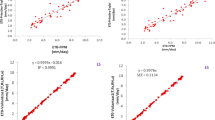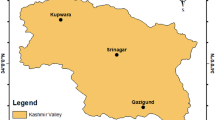Abstract
Evapotranspiration has a highlighted role in agricultural and forest meteorology researches, hydrological cycle, irrigation scheduling, and water resources management. There are many models to estimate the evapotranspiration including mass transfer, radiation, temperature, and pan evaporation-based models. This study aims to compare temperature-based models to detect the best model under different weather conditions. For this purpose, weather data were gathered from 181 synoptic stations in 31 provinces of Iran. The evapotranspiration was estimated using 11 temperature-based models and was compared with the FAO Penman-Monteith model. The results showed that the Modified Hargreaves-Samani models estimate the evapotranspiration better than other models in the most provinces of Iran (25 provinces). However, the values of R2 were less than 0.98 for 15 provinces of Iran. Therefore, the models were calibrated and preciseness of estimation was increased. However, the estimation was improved only in 14 provinces. The new temperature-based models estimated the evapotranspiration in the eastern (RK, NK, SB, and KE) provinces of Iran (with a various temperature range 14–20 °C) better than other provinces. The best precise methods were the Modified Hargreaves-Samani 1 method for AL (before calibration) and the Modified Hargreaves-Samani 3 method for KE (after calibration). Finally, a list of the best performance of each model has been presented to use other regions and next researches according to values of mean, maximum, and minimum temperature, elevation, minimum and mean relative humidity, sunshine, precipitation, and wind speed. The results are also useful for selecting the best model when we must apply temperature-based models because of type of available data.






Similar content being viewed by others
References
Abbaspour KC (1991) A comparison of different methods of estimating energy-limited evapotranspiration in the peace river region of British Columbia. Atmos Ocean 29(4):686–698
Acheampong PK (1986) Evaluation of potential evapotranspiration methods for Ghana. Geol J 12(4):409–415
Allen RG, Pereira LS, Raes D, Smith M (1998) Crop evapotranspiration. Guidelines for computing crop water requirements. FAO Irrigation and Drainage. Paper no. 56. FAO, Rome.
Baier W (1971) Evaluation of latent evaporation estimates and their conversion to potential evaporation. Canad J Plant Sci 51:255–266
Baier W, Robertson GW (1965) Estimation of latent evaporation from simple weather observations. Canad J Plant Sci 45:276–284
Basharat M, Tariq AR (2013) Spatial climate variability and its impact on irrigated hydrology in a canal command. Arab J Sci Eng 38(3):507–522
Bhartiya KM, Ghare AD (2014) Relative humidity based model for estimation of reference evapotranspiration for western plateau and hills region of India. Water Resour Manag. doi:10.1007/s11269-014-0644-9
Blaney HF, Criddle WD (1950) Determining water requirements in irrigated areas from climatological and irrigation data. Soil conservation service technical paper 96, Soil conservation service. US Department of Agriculture, Washington.
Bormann H (2011) Sensitivity analysis of 18 different potential evapotranspiration models to observed climatic change at German climate stations. Clim Chang 104(3–4):729–753
Droogers P, Allen RG (2002) Estimating reference evapotranspiration under inprecise data conditions. Irrig Drain Syst 16:33–45
El-Shafie A, Najah A, Alsulami HM, Jahanbani H (2014) Optimized neural network prediction model for potential evapotranspiration utilizing ensemble procedure. Water Resour Manag 28(4):947–967
Hargreaves GL, Samani ZA (1985) Evapotranspiration from temperature. Appl Eng Agr 1(2):96–99
Irmak S, Irmak A, Allen R, Jones J (2003) Solar and Net Radiation-Based Equations to Estimate Reference Evapotranspiration in Humid Climates. J Irrig Drain Eng 129(5):336–347
Jakimavicius D, Kriauciuniene J, Gailiusis B, Sarauskiene D (2013) Assessment of uncertainty in estimating the evaporation from the Curonian Lagoon. BALTICA 26(2):177–186
Kim S, Singh VP, Seo Y, Kim HS (2014) Modeling Nonlinear Monthly Evapotranspiration Using Soft Computing and Data Reconstruction Techniques. Water Resour Manag 28(1):185–206
Kisi O, Cengiz TM (2013) Fuzzy genetic approach for estimating reference evapotranspiration of Turkey: Mediterranean region. Water Resour Manag 27(10):3541–3553
McKenney MS, Rosenberg NJ (1993) Sensitivity of some potential evapotranspiration estimation methods to climate change. Agr Fores Meteorol 64(1):81–110
Mohan S (1991) Intercomparison of evapotranspiration estimates. Hydrol Sci J 36(5):447–460
Papadavid G, Hadjimitsis DG, Toulios L, Michaelides S (2013) A modified SEBAL modeling approach for estimating crop evapotranspiration in semi-arid conditions. Water Resour Manag 27(9):3493–3506
Perugu M, Singam AJ, Kamasani CSR (2013) Multiple linear correlation analysis of daily reference evapotranspiration. Water Resour Manag 27(5):1489–1500
Pereira AR, Pruitt WO (2004) Adaptation of the Thornthwaite scheme for estimating daily reference evapotranspiration. Agr Water Manag 66(3):251–257
Schendel U (1967) Vegetationswasserverbrauch und -wasserbedarf. Habilitation, Kiel, p 137
Shadmani M, Marofi S, Roknian M (2012) Trend analysis in reference evapotranspiration using Mann-Kendall and Spearman’s Rho tests in arid regions of Iran. Water Resour Manag 26(1):211–224
Thornthwaite CW (1948) An approach toward a rational classification of climate. Geogr Rev 38:55–94
Trajkovic S (2007) Hargreaves versus Penman–Monteith under Humid Condition. J Irrig Drain Eng 133:38–42
Valipour M (2012a) Ability of Box-Jenkins models to estimate of reference potential evapotranspiration (A Case Study: Mehrabad Synoptic Station, Tehran, Iran). IOSR J Agr Veter Sci (IOSR-JAVS) 1(5):1–11
Valipour M (2012b) Critical areas of Iran for agriculture water management according to the annual rainfall. Eur J Sci Res 84(4):600–608
Valipour M (2014a) Temperature analysis of reference evapotranspiration models. Meteorol Applicat. doi:10.1002/met.1465
Valipour M (2014b) Drainage, waterlogging, and salinity. Arch Agron Soil Sci. doi:10.1080/03650340.2014.905676
Valipour M (2014c) Future of the area equipped for irrigation. Arch Agron Soil Sci. doi:10.1080/03650340.2014.905675
Valipour M (2014d) Importance of solar radiation, temperature, relative humidity, and wind speed for calculation of reference evapotranspiration. Arch Agron Soil Sci. doi:10.1080/03650340.2014.925107
Valipour M (2014e) Land use policy and agricultural water management of the previous half of century in Africa. Appl Water Sci. doi:10.1007/s13201-014-0199-1
Valipour M (2014f) Application of new mass transfer formulae for computation of evapotranspiration. J Appl Water Eng Res 2(1):33–46
Valipour M (2014g) Future of agricultural water management in Americas. J Agr Res 52(2):245–268
Valipour M (2014h) Handbook of water engineering problems. Foster city, CA: OMICS Group eBooks. www.esciencecentral.org/ebooks/handbook-of-water-engineering-problems/pdf/handbook-of-water-engineering-problems.pdf
Valipour M (2014i) Future of agricultural water management in Europe based on socioeconomic indices. Acta Adv Agr Sci 2(7):1–18
Valipour M, Banihabib ME, Behbahani SMR (2012a) Monthly inflow forecasting using autoregressive artificial neural network. J Appl Sci 12(20):2139–2147
Valipour M, Banihabib ME, Behbahani SMR (2012b) Parameters estimate of autoregressive moving average and autoregressive integrated moving average models and compare their ability for inflow forecasting. J Math Stat 8(3):330–338
Valipour M, Banihabib ME, Behbahani SMR (2013) Comparison of the ARMA, ARIMA, and the autoregressive artificial neural network models in forecasting the monthly inflow of Dez dam reservoir. J Hydrol 476:433–441
Valipour M, Montazar AA (2012a) Optimize of all effective infiltration parameters in furrow irrigation using visual basic and genetic algorithm programming. Austral J Basic Appl Sci 6(6):132–137
Valipour M, Montazar AA (2012b) Sensitive analysis of optimized infiltration parameters in SWDC model. Adv Environ Biol 6(9):2574–2581
Xu CY, Chen D (2005) Comparison of seven models for estimation of evapotranspiration and groundwater recharge using lysimeter measurement data in Germany. Hydrol Process 19:3717–3734
Xu CY, Singh VP (2000) Evaluation and generalization of radiation-based methods for calculating evaporation. Hydrol Process 14(2):339–349
Xu CY, Singh VP (2002) Cross comparison of empirical equations for calculating potential evapotranspiration with data from Switzerland. Water Resour Manag 16(3):197–219
Yoder RE, Odhiambo LO, Wright WC (2005) Evaluation of methods for estimating daily reference crop evapotranspiration at a site in the humid southeast United States. Appl Eng Agr 21(2):197–202
Yuan W, Liu S, Liang S, Tan Z, Liu H, Young C (2012) Estimations of evapotranspiration and water balance with uncertainty over the Yukon River Basin. Water Resour Manag 26(8):2147–2157
Zhai L, Feng Q, Li Q, Xu C (2010) Comparison and modification of equations for calculating evapotranspiration (ET) with data from Gansu Province, Northwest China. Irrig Drain 59:477–490
Author information
Authors and Affiliations
Corresponding author
Rights and permissions
About this article
Cite this article
Valipour, M. Use of average data of 181 synoptic stations for estimation of reference crop evapotranspiration by temperature-based methods. Water Resour Manage 28, 4237–4255 (2014). https://doi.org/10.1007/s11269-014-0741-9
Received:
Accepted:
Published:
Issue Date:
DOI: https://doi.org/10.1007/s11269-014-0741-9




